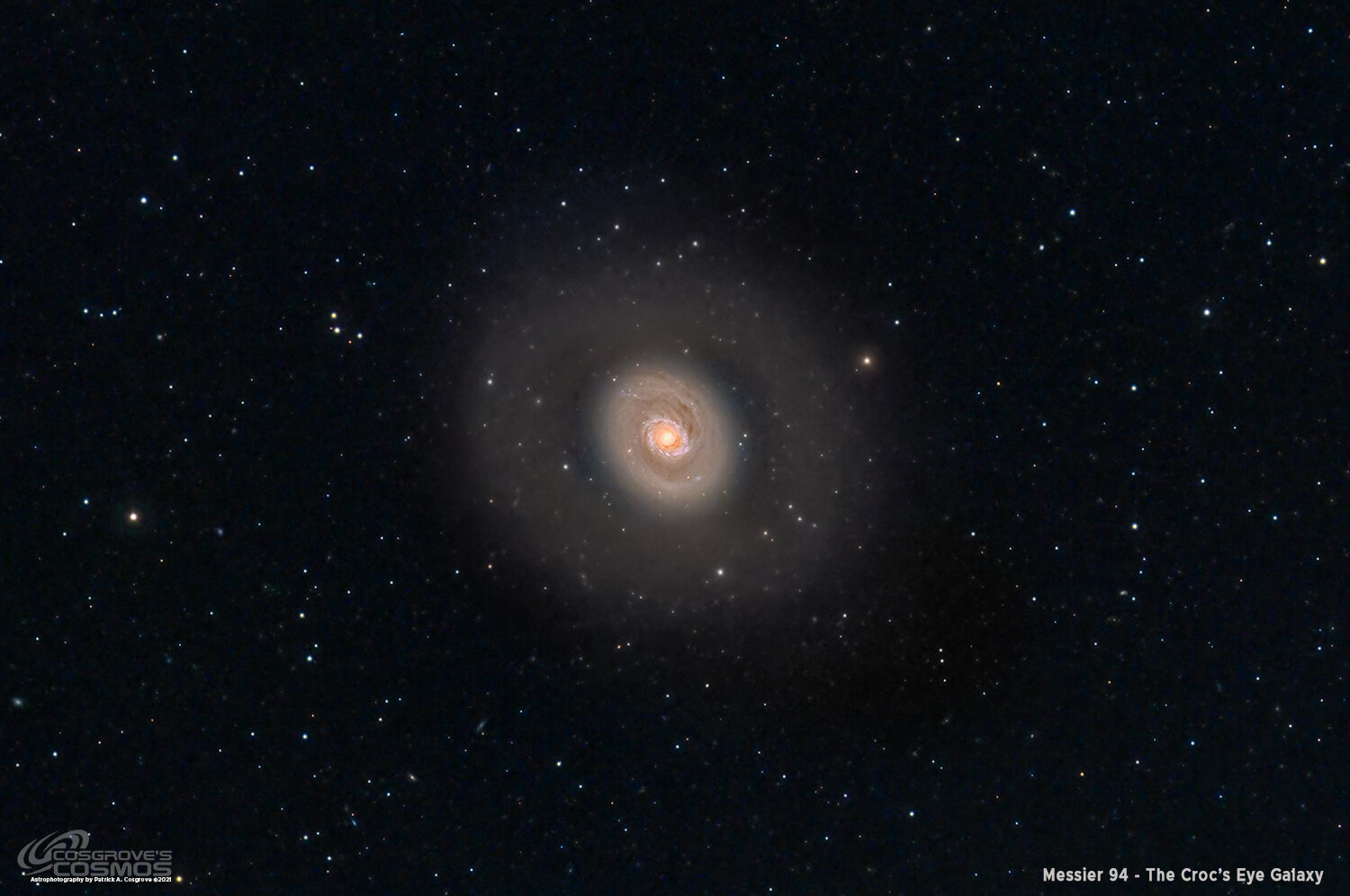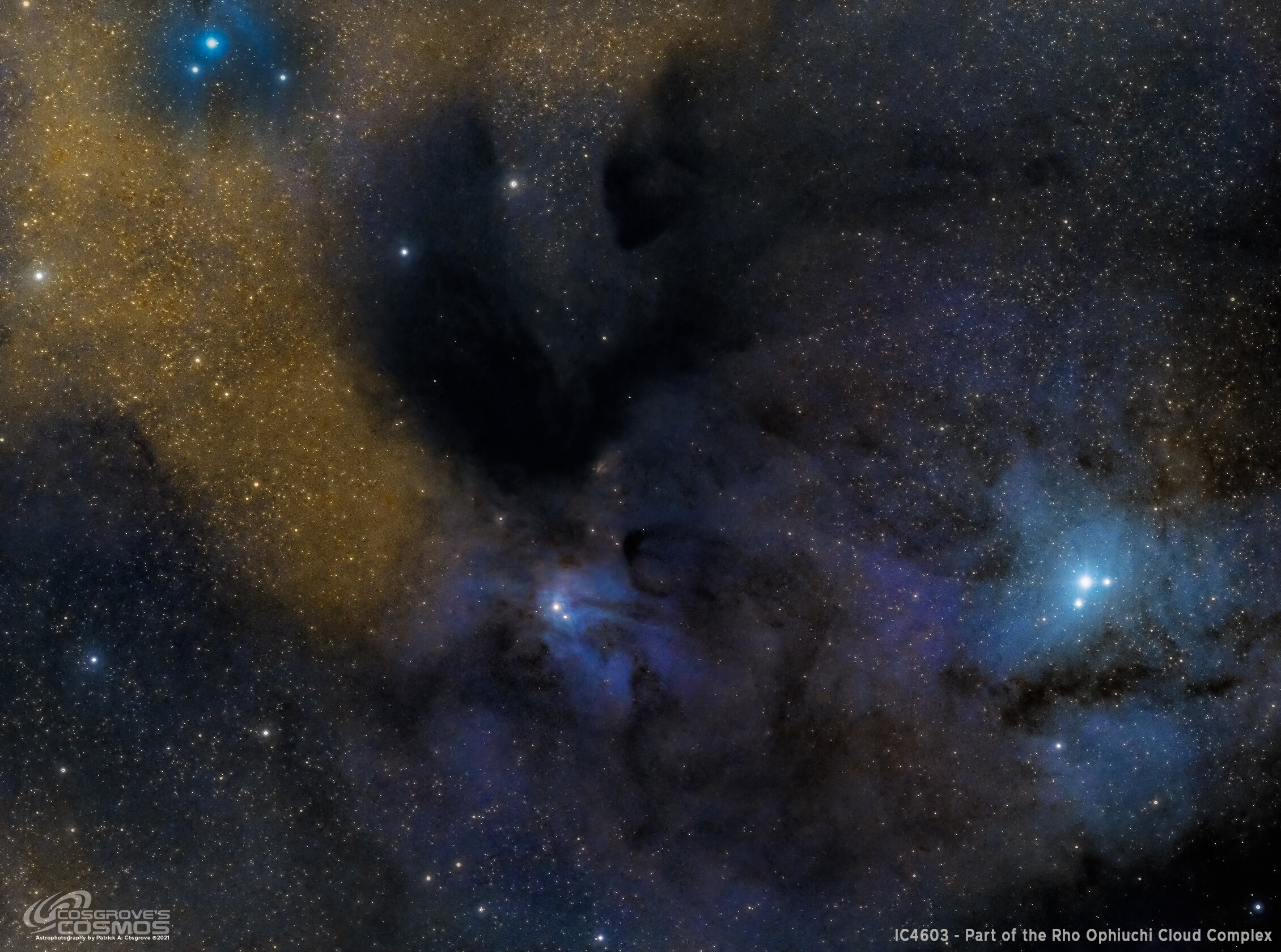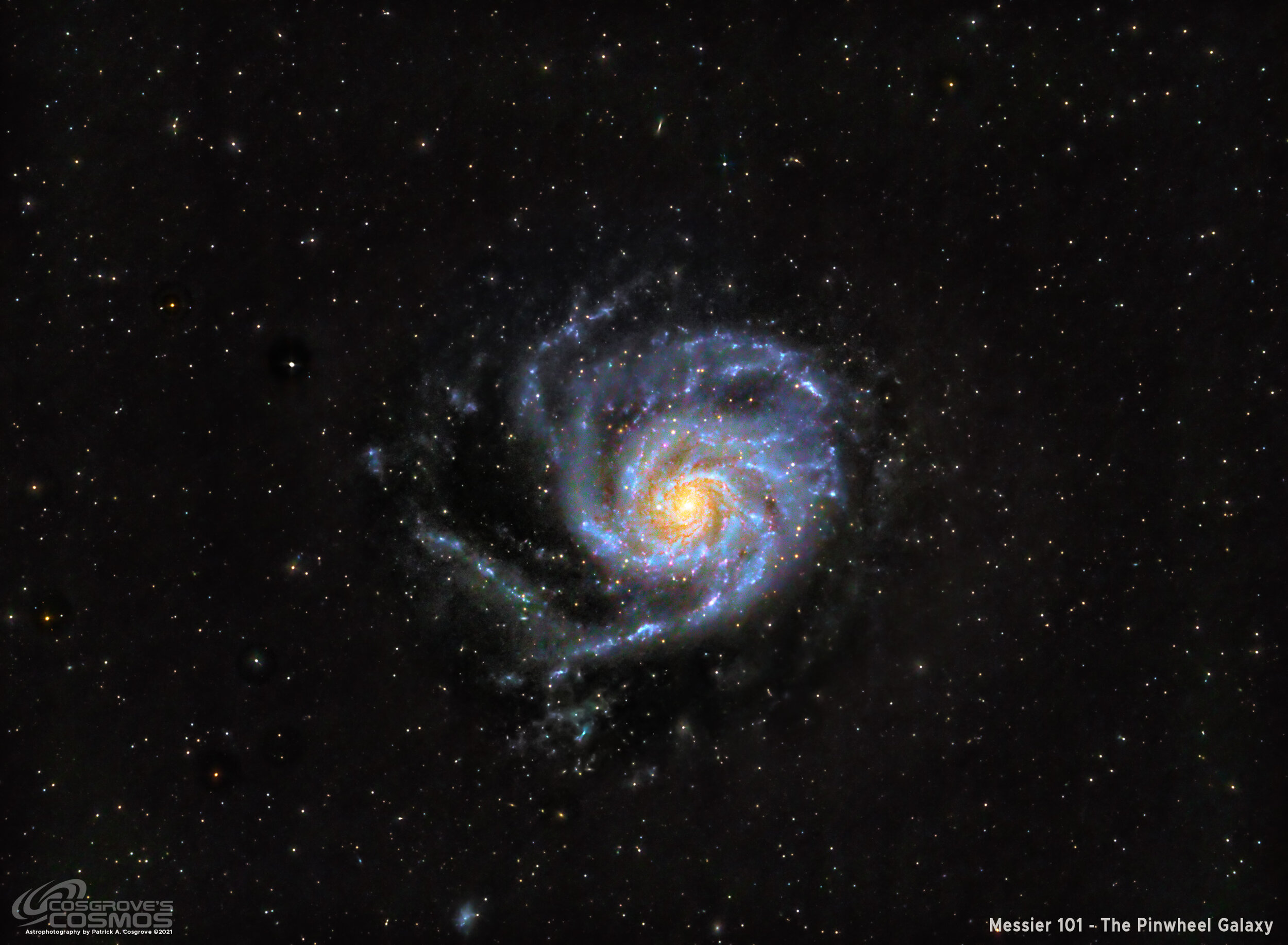Imaging Projects
In this blog, I will share the results of all of my imaging projects. The newest will be at the top and the oldest will be further down the stack. Going back in time here is interesting - some of my early stuff was pretty rough - but I did not see it that way at the time - I was thrilled to get anything back that looked like an image! Hopefully, you will see how my work has progressed with time!

Revisiting the Draco Triplet: NGC 5981, NGC 5982, & NGC 5985
The Draco Trio consists of a close grouping of three very different looking galaxies, found in the constellation Draco. These are small targets for my scope so I needed to carefully process the images to get the most detail possible. See how I did it!

Messier 94 - The Croc’s Eye Galaxy in LRGB
Messier 94 is also known as NGC 4736 and has at least two common names: "The Cat' Eye Galaxy" and "The Croc's Eye Galaxy", with the later of which seems more popular this days. This galaxy is located 16 Million Light Years away in the Constellation Canes Venatici (The Hunting Dogs). Shot over two evenings in last June of 2021 using my William Optics 132 FLT Plafrform and the ASI1600M-Pro Mono Camera.

NGC 3718 /ARP 214 - The Twisted Galaxy
NGC 3718, also know as ARP 214, is a distorted spiral galaxy in the Constellation Ursa Major and is located about 59 Million Light Years away. Its distorted form is thought to be gravitational interaction with the other galaxy seen in this image - NGC 3729 - at some point in the distant past. These are all part of a group of galaxies known as the Ursa Major Cluster.

IC4603/4604 and a Portion of the Rho Ophiuchi Cloud Complex in LRGB
The Rho Ophiuchi cloud complex is a dark nebula of gas and dust that is located near the star Rho Ophiuchi of the constellation Ophiuchus. At an estimated distance of 460 light-years, it is one of the closest star-forming regions to our Solar System. This region is quite large, covering an angular area of the sky that measures 4.5 x 6.5 degrees in size.

Messier 51 - The Whirlpool Galaxy in HaLRGB
Messier 51, also know as NGC 5194 is more famously known as the Whirlpool Galaxy. It can be found in the constellation Canes Venatici and is estimated to be about 31 Million Light Years from Earth. M51 was the first galaxy to be classified as having a Spiral and is know o have a Seyfert 2 active galactic core.

Messier 13 - The Great Globular Cluster - First Light for My Askar FRA400 Platform
Messier 13: The Great Globular Cluster in LRGB - First light on my new portable rig.
I have recently shared my efforts to pull together a new lightweight portable rig - but at that time I had NOT yet tested it and confirmed that it would perform to my satisfaction. This test confirmed the viability of the platform.

M101 - The Pinwheel Galaxy: Things don't always work out!
I first shot the Pinwheel Galaxy last year using my One-Shot-Color Camera. I wanted to try it again and see what I could get using a mono camera and L,R,G,B & Ha filters with a longer set of exposures.
So I recently imaged this target over the span of 5 nights, starting on May13. I collected the normal LRGB filter data and I also collected some narrowband images through my Hydrogen-Alpha Filter. The equipment is pretty automated now so I could get things running and then try to sleep on the sofa - still keeping a general eye on things during the night…..

Messier 63 - The Sunflower Galaxy in HaLRGB (First Light on My New ZWO ASI2600MM-Pro Camera!)
Messier 63, The Sunflower Galaxy in LRGB. First image using the new ZWO ASI2600mm-Pro Camera!

C49: The Rosette Nebula in SHO
Astrobin Top Pick!
Also known as the "Skull Nebula" and Caldwell 49, the Rosette Nebula is a large HII region of bright gas and filaments of dark dust, located in the constellation of Monoceros. The open cluster NGC 2244 (discovered by John Flamsteed in 1690) is associated with this region - the stars of which were formed within this molecular cloud. Located 5000 light years away, and measuring 65 light years in diameter,

NGC 4631 - The Whale and the Hockey Stick (NGC 4656) - A second attempt, this time in LRGB-Ha…
The Whale and the Hockeystick are two galaxies are found in the constellation Canes Venatici, about 30 Million Light years away. This is my second time shooting this target and the first where I used a mono camera and captured LRGB along with some Ha subs folded in for good measure. As it worked out, I captured a possible supernova that was recently discovered as well.

Messier 81: Bode's Galaxy and Messier 82: the Cigar Galaxy
Messier 81, also known as NGC 3031 and Bode's Galaxy, is a beautiful spiral galaxy located 12 Million light years away in the constellation Ursa Major. This post tells the story of this capture -which consists of 9.9 hours of integration using the ZWO ASI294MC-Pro and the William Optics 132mm FLT APO Platform.

Messier 65, 66, and NGC 3628: The Leo Triplet
The Leo Triplet, also known as the M66 group, is a small group of galaxies located about 35 million light-years away in the constellation Leo. The three prominent galaxies involved are M65 (bottom left), M66 (top left), and NGC 3628 (right). 2.9-hour integration on the William Optics 132mm Telescope Platform

Messier 108 - The Surfboad Galaxy
Messier 108, also known as NGC 3556 and the "Surfboard Galaxy", is a barred spiral galaxy located in the constellation of Ursa Major and is 45.9 Million Light years away. M108 is about 110,00 light-years across and presents at an angle of 75 degrees from our line of sight. M108 has a massive black hole at its center that is estimated to be 24 million solar masses - about 8 times the size of the black hole at the core of our own Milky Way.

Messier 74 - The Phantom Galaxy
Messier 81, also known as NGC 3031 and Bode's Galaxy, is a beautiful spiral galaxy located 12 Million light-years away in the constellation Ursa Major. This post tells the story of this capture -which consists of 9.9 hours of integration using the ZWO ASI294MC-Pro and the William Optics 132mm FLT APO Platform.

SH2-155 - The Cave Nebula
SH2-155 - The Cave Nebula - also known as Caldwell 9, is a diffuse nebula found in the constellation Cepheus. It is actually a part of a much larger complex of nebulae n the region which includes the emission, reflection, and dark nebulae. The designation indicates that this part of the Sharpless Catalog of emission nebulae which are located north of the declination -27 degrees. Sh2-155 is located 2400 light-years away and is an ionized HII region with evidence of star formation activity.

IC 405 - The Flaming Star Nebula
IC 405 - The Flaming Star Nebula, also known as Caldwell 31, is a nebula in the constellation Auriga surrounding the bright blue irregular variable star AE Aurigae. This nebula is located about 1500 light-years away and is about 5 light-years across. The red portions are from emission nebulae, while the bluer portions are reflection nebulae, reflecting the light of AE Aurigae.

IC 1795 - The Fish Head Nebula in SHO
IC 1795, also know as the Fish Head Nebula, is an area of new star formation with glowing gas and dust, in the constellation of Cassiopeia. It is actually a portion of the larger Heart Nebula complex (IC 1805) that is located about 6000 light-years from earth. Since my scope cannot fit the entire Heart nebula into its field of view, I opted to frame just the fish head portion of the nebula. This was to be shot with my Mono camera and narrowband filters so that I could get the Hubble Palette colors that I am quite fond of.

NGC 281 - The Pacman Nebula in the Hubble Palette
NGC 281 - The Pacman Nebula. Also known as IC 11 and Sh2-18,4 this is a bright emission nebula located 9500 light-years away in the constellation of Cassiopeia and is part of the Perseus arm of our own Milky Way galaxy. Captured with a mono camera on my Astro-Physics 130mm Platform.

Messier 1 - The Crab Nebula with an SHO/RGB Blend
Messier 1 - The Crab Nebula. Also, known as NGC 1952 and Taurus A. Now, THIS is a pretty cool object! This is the remains of a star that went Supernova and was seen as a bright daytime star back in 1054 by Chinese Astronomers. It was discovered by English astronomer John Bevis in 1731. It was also independently discovered by Charles Messier in 1758 when he was trying to find the return of Halley's Comet.

IC 5070 - The Pelican Nebula in SHO
IC 5070 - The Pelican Nebula. This rich region of gas and dust is located 1800 light-years away in the constellation of Cygnus, the Swan. It is separated from the North American Nebula by a dark region of dust. The Pelican Nebula is very active in star formation and the growing collection of hot new stars being created there are slowly transforming cold gasses to hot gases that are ionized.
